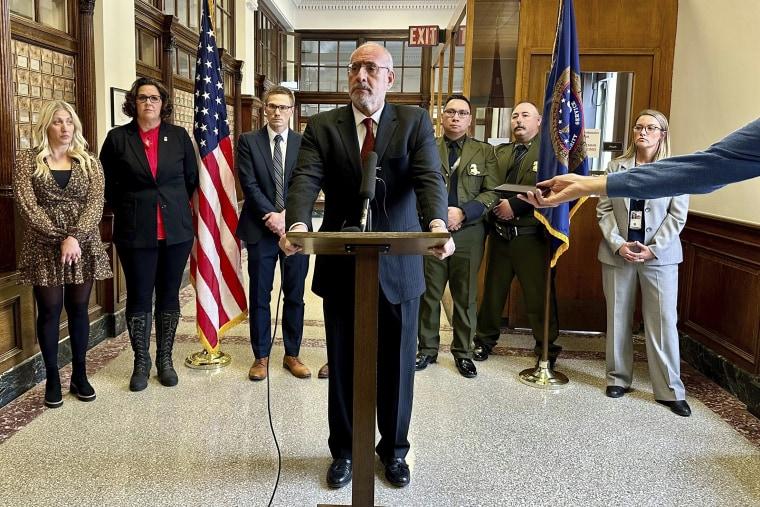Guatemalan National Indicted in Connection with Fatal Migrant Smuggling Incident
Federal prosecutors have formally charged a Guatemalan individual implicated in the tragic deaths of 53 migrants discovered inside a sealed tractor-trailer near San Antonio, Texas. The indictment accuses the suspect of orchestrating a human smuggling scheme that culminated in one of the deadliest migrant tragedies in recent U.S. history. Authorities stress that the suspect’s involvement directly contributed to the loss of life, highlighting the severe consequences of illicit smuggling operations.
Highlights from the indictment include:
- The suspect allegedly facilitated the illegal transport of migrants across the U.S.-Mexico border under life-threatening conditions.
- Charges include conspiracy to transport undocumented migrants resulting in death, alongside other federal offenses.
- Investigations remain active to uncover the full scope of the smuggling network and identify additional participants.
| Charge | Potential Sentence |
|---|---|
| Conspiracy to Transport Illegal Aliens Resulting in Death | Life Imprisonment |
| Illegal Transportation of Migrants | Up to 10 Years |
| Additional Federal Violations | Varies |
Examining the Deadly Conditions Inside the Trailer
The grim discovery of 53 deceased migrants inside a confined trailer has prompted an extensive inquiry into the hazardous smuggling operation. Investigators revealed that the victims succumbed to suffocation and heatstroke due to extreme temperatures and lack of ventilation within the enclosed space. First responders described the scene as a stark reminder of the perilous risks migrants endure during their journeys.
Authorities identified several critical factors that led to this catastrophe, underscoring the calculated negligence of the trafficking ring:
- Severe overcrowding: The trailer was packed far beyond its intended capacity, leaving little room for air or movement.
- Harsh environmental conditions: Internal temperatures reportedly soared above 100°F (38°C), with no airflow to alleviate the heat.
- Profit-driven disregard: The smugglers prioritized financial gain over human safety, creating a lethal environment for those inside.
| Incident Detail | Information |
|---|---|
| Location | San Antonio, Texas vicinity |
| Fatalities | 53 Migrants |
| Suspect’s Nationality | Guatemalan |
| Charges | Human Smuggling, Involuntary Manslaughter |
Navigating Legal Complexities in Cross-Border Human Smuggling Prosecutions
The recent indictment highlights the intricate legal landscape surrounding cross-border human smuggling and trafficking prosecutions. Federal authorities must balance domestic laws with international cooperation to effectively bring perpetrators to justice, especially when crimes result in fatalities. This case exemplifies the application of statutes such as the Trafficking Victims Protection Act (TVPA) alongside immigration regulations, which collectively provide a framework for prosecuting offenders while safeguarding migrant rights.
Key legal challenges in these cases often involve:
- Jurisdictional complexities: Determining prosecutorial authority when offenses span multiple countries.
- Evidence collection: Coordinating with foreign agencies to obtain witness statements, digital data, and physical proof.
- Protection of victims: Ensuring survivors and families receive legal support and security throughout the judicial process.
| Legal Factor | Impact |
|---|---|
| Extradition Procedures | Complexities in transferring suspects internationally |
| Sentencing Guidelines | Severe penalties for smuggling linked to deaths |
| International Collaboration | Crucial for dismantling trafficking networks and enforcing laws |
Strategies to Enhance Migrant Protection and Border Security
Addressing the dangers faced by migrants requires a comprehensive strategy that combines enhanced border enforcement with humanitarian safeguards. Strengthening bilateral and multilateral cooperation between the U.S. and Central American nations is essential for disrupting smuggling operations through improved intelligence sharing and joint law enforcement efforts. Additionally, deploying cutting-edge technologies such as AI-driven surveillance and biometric systems can facilitate early detection of illicit activities while respecting human rights.
Equally important are community-based initiatives in migrants’ home countries that educate vulnerable populations about the risks of unauthorized migration and promote legal migration alternatives. Expanding humanitarian services at border points—including medical care, shelter, and legal assistance—can significantly reduce mortality rates during transit. The following table summarizes key recommended interventions:
| Intervention | Objective | Expected Outcome |
|---|---|---|
| Cross-Border Law Enforcement Cooperation | Enhance joint operations and intelligence exchange | Disrupt and dismantle smuggling networks |
| Advanced Surveillance Technologies | Implement real-time monitoring systems | Early identification and prevention of smuggling attempts |
| Community Education Programs | Raise awareness about migration risks | Decrease irregular migration flows |
| Humanitarian Support at Borders | Provide medical, shelter, and legal aid | Reduce migrant fatalities and improve wellbeing |
Conclusion
The indictment of the Guatemalan suspect represents a pivotal moment in the investigation of the tragic deaths of 53 migrants found in a Texas trailer. This case underscores the ongoing hazards faced by individuals attempting to cross borders through illegal means and highlights the U.S. government’s commitment to dismantling human smuggling operations. As legal proceedings advance, further developments are anticipated, reinforcing the urgent need for comprehensive solutions to the humanitarian and security challenges posed by irregular migration.




